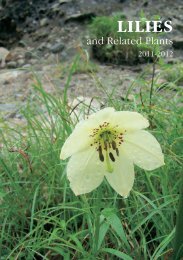LILIES - RHS Lily Group
LILIES - RHS Lily Group
LILIES - RHS Lily Group
You also want an ePaper? Increase the reach of your titles
YUMPU automatically turns print PDFs into web optimized ePapers that Google loves.
The conservation of wild lily<br />
populations in Japan<br />
For many years Katsuro Arakawa has been a major donor to the<br />
<strong>Lily</strong> <strong>Group</strong>’s seed distribution scheme. Here, he describes the<br />
conservation work he is involved with in Japan.<br />
Y FIRST CONTACT with the <strong>RHS</strong> <strong>Lily</strong> <strong>Group</strong> was in the winter of 1989, when<br />
MI<br />
was building the collection of live lilies at Yurigahara Park in Sapporo. I<br />
remember my excitement at the inspiring present of goodly amount of various<br />
lily seeds from the <strong>Group</strong>’s seed distribution in the spring of 1990.<br />
I owe many salutary lessons to this seed exchange – and not just that, but it<br />
has also brought me new friends in diverse corners of the world. I have had great<br />
pleasure from imagining each person’s gardening life, from the letters and emails<br />
they send me.<br />
Since spring 1996, we have organised our own domestic seed distribution,<br />
here in Japan. And our own <strong>Lily</strong> Society has now been established, grown from<br />
the initial nucleus of lily lovers brought into contact with each other through our<br />
domestic seed distribution. Some members are on the staff of botanic gardens,<br />
in charge of their lily collections. Our seed distribution helps to avoid inbreeding<br />
problems such as loss of vigour, and is a valuable fallback resource if and when<br />
strains are accidentally lost. The same of course is true of the <strong>RHS</strong> <strong>Lily</strong> <strong>Group</strong>’s<br />
distribution, and seeds which we are able to supply to that distribution seem to<br />
play the same role.<br />
Our <strong>Lily</strong> Society prints The <strong>Lily</strong> Society News in spring and autumn, and organises<br />
a <strong>Lily</strong> Tour in the flowering season. We have visited the World <strong>Lily</strong> Gardens at<br />
Yurigahara Park, private lily breeders, agricultural institutes in Hokkaido, and the<br />
natural habitats of Lilium dauricum and L. japonicum. In 2006 the <strong>Lily</strong> Society<br />
held a programme of lily lectures to celebrate its fifth anniversary.<br />
We plan to hold such lectures every five years, and major topics for us will be<br />
the history of relationships between human beings and lilies, and the fragrance of<br />
lilies. It is 175 years since L. speciosum was taken back by Siebold and flowered<br />
for the first time in Europe. We have long been aware of the beauty of the<br />
lily’s form and colouring, and now find great value too in its fragrance. There<br />
is also growing interest in the importance of the fragrance to the relationship<br />
between the lily and its pollinators, and in its relevance to perfume manufacture.<br />
Fragrant lilies like L. alexandrae, L. auratum, L. japonicum, L. nobilissimum and<br />
L. rubellum are Japanese endemics. Adding L. longiflorum, six species out of 14<br />
native to Japan are fragrant.<br />
9




